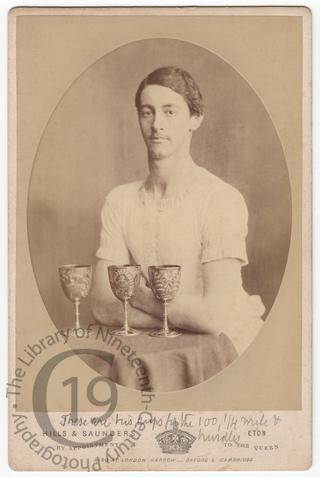
William Page Phillips
A cabinet card portrait of William Page Phillips (1858-1884), who enjoyed no small measure of success as an athlete, both during his time at Eton and afterwards, until his early death at the age of only 25. His obituary in Sporting Life (28 March 1884) called him ‘one of the greatest and most popular athletes of modern times.’ He stood 6 foot 2½ inches tall.
Born in 1858, William Page Phillips was the elder son of barrister William Page Thomas Phillips of Brentbridge House in Hendon, later a magistrate of 77 Gloucester Place, Marylebone (1871 census). He was baptised on 6 November 1858 at St Mary’s, Hendon.
He entered Eton in 1871, where he made a name for himself as a rower, a footballer and above all as an athlete. According to his obituary, ‘he was never happier than when attending or participating in an athletic meeting or regatta. […] At the College sports he won the 100 yards, quarter [mile], 120 yards hurdles, and high jump, besides running third for the mile.’ This corresponds almost exactly with the inscription in the lower margin of this portrait, which reads: ‘These are his cups for the 100, ¼ mile & hurdles.’
When he left Eton at Easter 1877, he joined the London Athletic Club where his achievements as an athlete continued to attract attention. Again according to his obituary, which gives a long and detailed account of his athletic career, ‘On several occasions Phillips beat record time, and five of his performances have never been eclipsed by any athlete residing in the United Kingdom.’
‘He was also a lieutenant in the 3rd Battalion of the Suffolk Regiment, gazetted March 18, 1882. During the recent Egyptian campaign, under the command of Sir Garnet Wolsey [sic], Phillips visited Egypt, and at the athletic sports held at Alexandria, he competed in nearly every event, conceding long starts to all the athletes there located, and for his fine performances was lustily cheered by the Bluejackets and officers of the Garrison.’
William Page Phillips died on 26 March 1884, having ‘taken ill with quinsy’ two days earlier. Today this would be called a peritonsillar abscess, an accumulation of pus between a tonsil and the wall of the throat, due to a bacterial infection. He was buried at Woodbridge in Suffolk.
Photographed by Hills and Saunders of Eton and other branches.
Code: 127665




